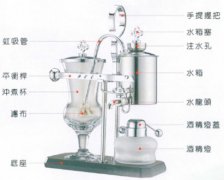Coffee pot use common sense mocha pot how to make coffee
Mocha pot is a way for Italians to make coffee, which is suitable for people with strong taste. The concentration of brewed coffee is close to that of Espresso, but because it does not produce enough pressure, it cannot be called Espresso in a strict sense. The pot is easy to brew, beautiful in shape and does not take up space, so it is a more economical choice for ordinary families. However, it must be noted that the grinding of coffee powder should be finer, and the cooking time and water quantity should be mastered.
In the early days, mocha pots were mostly made of aluminum, but now they are mostly made of stainless steel.
Steps:
Step1 pours water into the lower kettle of the mocha kettle (hot water is also acceptable). Be careful that the water is not higher than the safety valve.
Step2 put the right amount of fine ground coffee powder into the middle coffee container and gently squeeze with the bottom and edge of the spoon to remove the gas from the coffee as much as possible and fill the gap on the edge of the small box. (it is best to fill the coffee container and gently flatten the coffee powder so that the water will stay in the coffee longer and the coffee will not be too thin.)
Step3 gently wiped off the coffee powder particles left on the edge of the small box with his fingers, and then put the small box on top of the lower pot filled with water.
Step4 tightens the top and bottom of the mocha pot, paying attention to keeping the pot upright so that the water doesn't soak the coffee too early.
Step5 heat the mocha pot over medium to low heat. And pour boiling water into the coffee cup and medium temperature cup.
Step6 when the water boils, the steam produced causes the water to enter the coffee through the funnel. Turn down the fire immediately (if the fire is still very big, the water will quickly filter the coffee, making the coffee sour and dilute); when there is a sound of water and bubbling in the upper pot, steam comes out in large quantities, and the aroma of coffee wafts out, it means the coffee is ready.
Step7 turns off the heat source, and after the bubbling stops, you can pour the pot of coffee into the cup and taste a cup of strong coffee.
Important Notice :
前街咖啡 FrontStreet Coffee has moved to new addredd:
FrontStreet Coffee Address: 315,Donghua East Road,GuangZhou
Tel:020 38364473
- Prev

How to use the Royal Belgian Pot for Coffee making
1. Turn off the faucet, turn on the water tank plug, fill the 420cc450cc with water, and then close the water injection port. two。 Put the right amount of coffee powder into the brewing cup as you like. 3. Press down the balancing rod, open the alcohol lamp lid, and light the alcohol lamp. 4. When the water in the kettle is boiled, the hot water is pushed from the kettle to the glass through the siphon (siphon principle) 5. The hot water in the kettle reaches behind the glass.
- Next

The technique of making coffee by using a common sense siphon pot
Siphon (siphon) coffee pot, also known as plug air pot, real pot, uses the principle of siphon to make coffee. The cooking process is full of experimental drama, and the conditioning process is simple, but the boiled coffee has a special mellow degree and aroma, which can not be compared with the ground coffee brewed by machine. This method is especially suitable for tasting non-heavily roasted coffee. Step: 1Step to rainbow
Related
- Beginners will see the "Coffee pull flower" guide!
- What is the difference between ice blog purified milk and ordinary milk coffee?
- Why is the Philippines the largest producer of crops in Liberia?
- For coffee extraction, should the fine powder be retained?
- How does extracted espresso fill pressed powder? How much strength does it take to press the powder?
- How to make jasmine cold extract coffee? Is the jasmine + latte good?
- Will this little toy really make the coffee taste better? How does Lily Drip affect coffee extraction?
- Will the action of slapping the filter cup also affect coffee extraction?
- What's the difference between powder-to-water ratio and powder-to-liquid ratio?
- What is the Ethiopian local species? What does it have to do with Heirloom native species?

